Inside communities that embrace transformation over transactions
Why new paths for community growth are following the oldest rules in the book
In December 2012, the term “followers” was searched more than the term “algorithm” for the first time in Google history. That year had seen the official purchase of Instagram by Facebook (now Meta), the launch of video sharing on Snapchat, and the debut of both apps on Android devices.
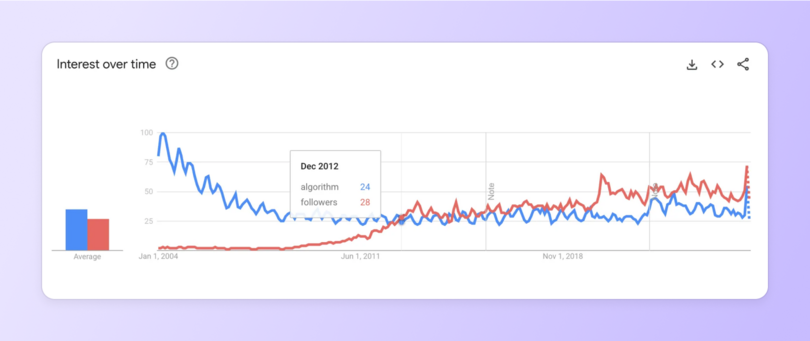
Its lead has reigned supreme ever since, a static reminder of what we were all supposed to aim for in the new age of the influencer: More followers, full stop.
The logic was easy to grasp, after all; a bigger platform meant more people to hear your message and convert into true customers and community members. The only thing keeping you from GaryVee or KimK levels of success was the number of zero’s in your follower count, not your bank account or the mysterious overlords of the algorithm.
And following that conventional wisdom, countless entrepreneurs set about turning their online brands into mega-platforms; expansive lands of masterminds, merch, and monetization. A quick trip through Facebook Groups can become a historical walking tour of this era: Hundreds of (usually private) FB Groups with member counts in the tens of thousands, but no activity in weeks or months.
This isn’t a scenario borne from the Dead Internet Theory, although they do have a lot in common. Because even though we stopped searching for the algorithm, it never stopped looking for us.
📚 Dead Internet Theory: A conspiracy theory that the vast majority of internet traffic, posts and users have been replaced by bots and AI-generated content, and that people no longer shape the direction of the internet.
How the For You Page (FYP) changed everything
Carmen Vicente, Gorgias' Social Media Manager, has a theory about how we got here. She sees social media history in two distinct eras: "Before FYP” and “After FYP"—with TikTok's introduction of the For You Page algorithm in 2016 as the turning point that "opened Pandora's box."
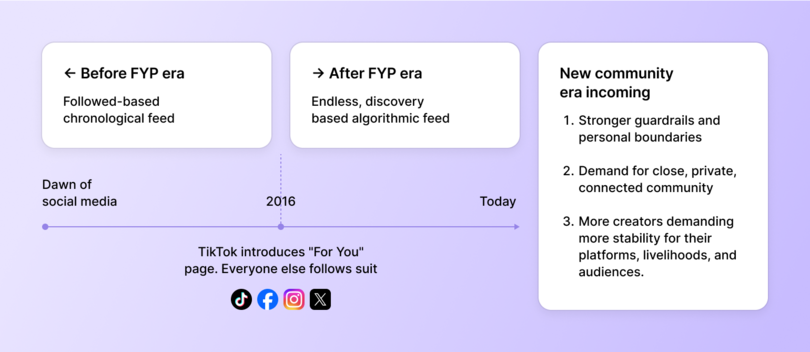
"We moved from a follower-based chronological feed to a discovery-based algorithmic feed," Vicente explains. That shift didn't just change what we saw—it fundamentally changed who we saw it from. Twitter, Facebook, and Instagram quickly followed suit with similar formulas, and very quickly, endless feeds of suggested content became the norm.
But Vicente believes we're approaching—or have already rounded—a corner on the next phase, based on three significant signals she's observing everywhere: algorithm hangovers, a return to community roots, and an absolute breaking point for creators whose livelihoods depend on reaching their followers.
🧐 Did you know...
Gorgias' hosts their ambassador and customer communities on Circle.
After the FYP? Crowds of strangers
The numbers tell the story of what happened after algorithms took over. A 2020 Pew Research Center survey found that a whopping 92% of posts on Twitter (now X) were created by just 10% of user accounts on the platform. The split was similarly vast on TikTok, where a 2024 survey found that 98% of posts were made by ~25% of users.
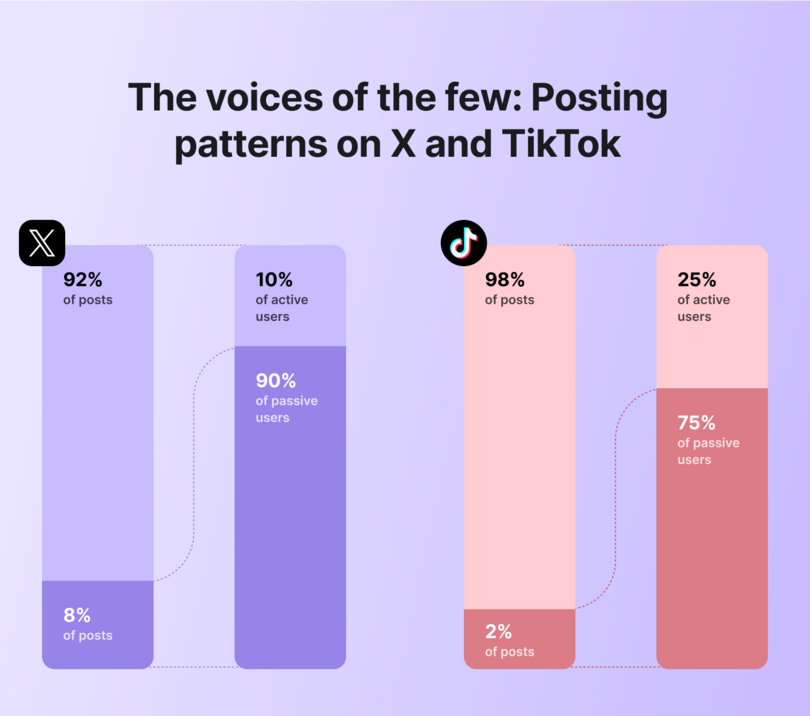
Similar patterns have been found, both officially and anecdotally, on every social media platform you can think of. It has brought us to the current moment—where people aren’t seeing posts from the people they actively chose to follow, but instead are constantly barraged with posts from strangers.
Mega-platforms don't do a great job of connecting a community if everyone sees something different when they open up the app, and this (among record levels of negative sentiment towards social media as a whole) has led to increasing amounts of people to stop posting altogether. The current state of social platforms has made it near-impossible for us to connect with our audiences—and each other.
Vicente calls the growing resistance to this form of social media an "algorithm hangover," adding: "People are becoming more aware of the negative side effects that accompany the endless scroll, and are demanding better guardrails, stronger legislation, and personal boundaries."
So…that’s it? Game over, thanks for playing, let’s all go back to carrier pigeons and wax-sealed letters, Bridgerton-style? Not quite. It turns out there’s a magic number between “none” and “Cristiano Ronaldo’s 664 million followers” when it comes to the amount of people it takes to gain all the benefits and excitement of a thriving community without losing sight of those connections in a sea of names and faces.
It's a concept that's been taking root everywhere from Discord to Circle, and is quite possibly the key to understanding how transformative communities are made and why they succeed. And, it was first popularized a decade before social media even existed.
Can you put a number on community? (Yes.)
In the early ‘90s, a British anthropologist named Robin Dunbar had a new hypothesis: He believed there was a hard number to the amount of people that can maintain stable social relationships with each other, where every person in the community knows everyone else and can track their relationship to every other person.
Dunbar broadly described the principle as “the number of people you would not feel embarrassed about joining uninvited for a drink if you happened to bump into them at a bar.” After a lot of science and double-checking by other primatologists, the scientific community landed on what is now known as Dunbar’s Number: 150 people.
(Technically, it was 150 primates, but it works just as well for humans.)
What Dunbar found was that across every era of human history, communities tended to splinter off into smaller settlements around the 150-person mark. For a variety of sociological and scientific reasons, we seem to only be able to hold that many strong personal connections in our brains before individuals turn into an anonymous crowd.
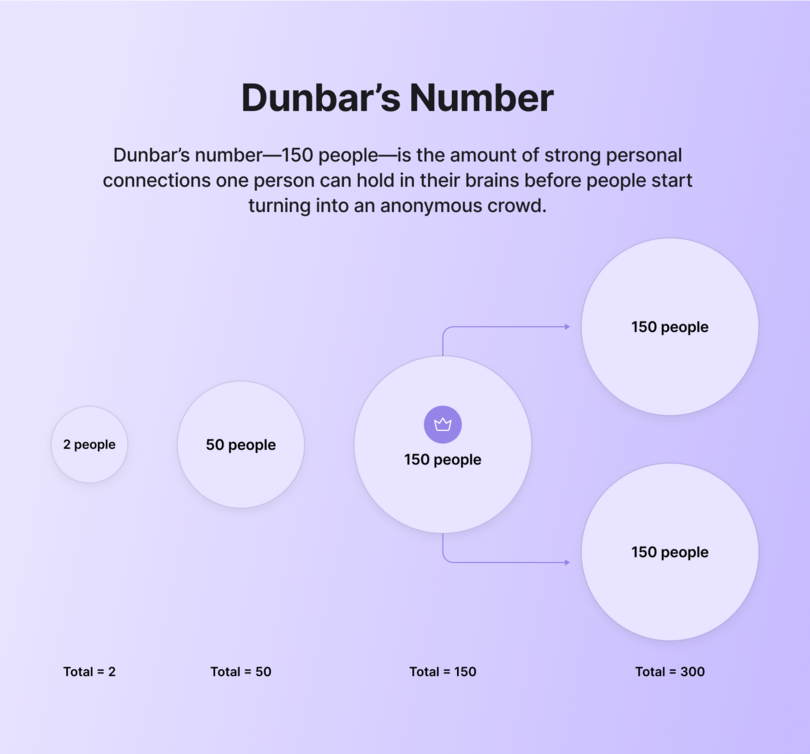
Once a community surpasses Dunbar’s Number, it becomes almost impossible for everyone in that community to remain equally connected. People will naturally break into smaller groups and cliques, naturally cutting things down until the people around us are at a manageable, memorable number that we can communicate and connect with.
While crowds of thousands of people are great for specific scenarios (like sporting events or music festivals), none of those situations are built to facilitate meaningful connection between individuals looking to communicate and transform each other.
Most of the time, they’re strictly transactional events: You pay an uncomfortable amount of money, and you receive one ticket to the Eras Tour. And while you may feel part of a like-minded crowd of Swifties, it’s nearly impossible that you’ll be able to learn or remember everyone else’s name at the end of the night. (Friendship bracelets or not.)
But that’s where the Age of the Follower has driven us: Chasing stadium concert levels of followers and subscribers, but creating communities of people who are feeling lost in the crowd. Which is how we’re already feeling thanks to the Age of the Algorithm turning us into strangers in our own social feeds!
The solution isn’t to grind harder, build bigger, or double down on CTAs for your existing audience. The solution lies with Dunbar’s Number—and the majority of Circle community leaders have already learned that it might represent the true sweet spot for communities that don’t just thrive, but survive.
Why 70% of thriving communities stay under 500 members
In the 2025 Circle Community Trends Report, one number immediately jumps out as being relevant to Dunbar’s hypothesis: 70%. That’s how many Circle communities are hovering around the Dunbar Number range of members, from 1 to 500.
In the follower-centric age of tracking success, those numbers might look disappointing. But remember: Once a community moves past 150 or so members, it essentially splits in two. And while that might be the right move for many communities depending on their focus and passion, it can be the exact opposite of what some leaders built their communities for to begin with.
Niche communities aren’t big communities waiting to happen; they’re already in their final, perfect form. Or to put it another way: Niche communities can exist within larger communities—just as the Dunbar Number suggests. In fact, it’s why so many successful entrepreneurs, like Pat Flynn, start creating membership tiers that bucket like-minded folks together.
That same report found that of all community sizes in Circle, it was the Small (101-500) communities that felt they were more successful than every other group size, with 90% of them reporting their 2024 success as very or moderately successful.
“Niche communities are growing because people are seeking deeper, more personal connections—not just with the creators they admire, but also with like-minded folks on similar journeys that they can relate to,” says Andy Guttormsen, co-founder and Chief Revenue Officer of Circle.
“These hyper-personalized spaces are intentionally smaller, which means more meaningful interactions, high-touch engagement, and a VIP-like experience.”
This preference towards smaller, more clearly-defined online spaces and communities isn’t just localized in a specific age range or interest group: In 2024, Adobe found that 98% of people who belong to a “small online community” felt a strong sense of kinship with that group, and you can see that exact phenomenon playing out again and again in ‘sweet spot communities’ all across Circle.
“Every group of people past a certain number starts to be less fruitful for those involved in the group,” says Matthew Carnevale, Head of Community for Exit Five.
“For people to feel connected and a sense of belonging, it’s better to put them in a small room (virtually or physically) with a group of people like them. A large group (or community in this case) just feels like a big room of strangers.”
If we can accept that the Dunbar Number represents the sweet spot for most communities, the question becomes: The sweet spot for what? What is happening in these double and triple-digit communities that could not be achieved in the crowds of a mega-community or the increasingly isolating void of every major social media platform?
It comes down to transactional versus transformational communities, and the place each one has in our lives. It’s time for some metaphors.
Treadmills vs. running trails
Transactional relationships are not inherently negative, and there are countless situations in which they’re the best option for everyone involved. Your hairdresser probably doesn’t want you to give them a trim and a dye job in return, for example. Money and time is exchanged for a service, and everyone who pays for a haircut receives one (and looks fresher than cut grass in the process).
This clarity becomes complicated when it comes to communities, because now your time and money are exchanged for access to a space, but the outcomes from that access are anything but straightforward.
This makes it more like a gym: Everyone pays the same membership fee, but their experiences will be unique. And like all gymgoers, new community members usually have a goal in mind: They want to transform something in their lives.
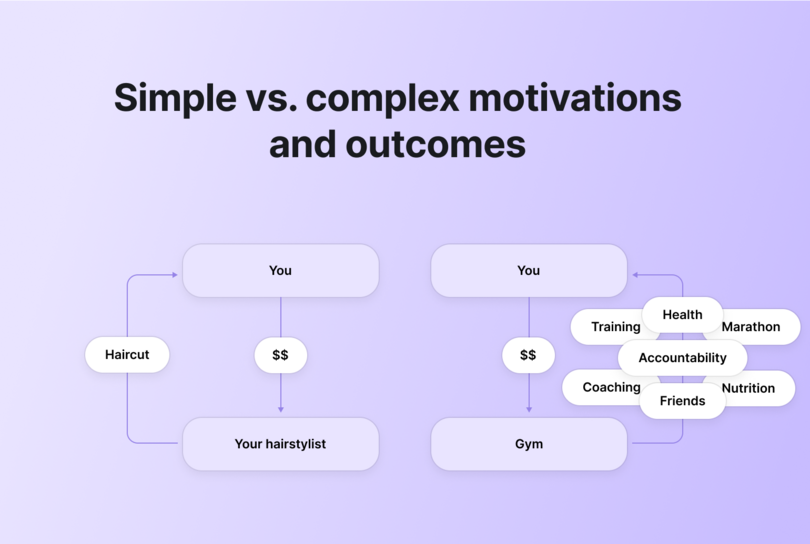
A new gym member might want to bench their body weight, master a dance they saw online, or train for an upcoming charity marathon. Their transactional participation in this community is directly tied to a transformational outcome in their future. For these gymgoers, accomplishing that goal might lead them to cancel their membership or find a new gym better suited to their needs or future goals. Which (as the circle of life has taught us) is totally fine and natural.
Others might have a less concrete, more vibes-based transformation: They might want to move their body 3-4 times a week, or make friends at their regular spin class. These people are more motivated by the personal, relationship-based transformation and accountability that they enjoy by being part of the gym’s community.
Realistically, most people carry a mix of both transformative motivations with them at all times—a fact that Psychology Today noted as being especially prominent in online fandoms, which served as both a source of social validation and growth/expertise in someone’s hobby or passion of choice.
So, people want to grow a specific part of their skillset or knowledge base while connecting with people they feel a kinship with at the same time. That sounds like the exact balance struck by sweet spot communities, right? Well, let’s go back to the gym example one more time.
Great communities support running trails of transformation
While your goal might be to train for that marathon for 3-4 months and then move to your next goal, your gym has a different goal: Keeping you enrolled as a paid member for as long as possible. Your primary value to the gym owner is as a perpetual source of revenue, and their ROI takes a nosedive if you feel compelled to move on.
Literally and figuratively, there is a common transactional model of membership that wants to keep you running in place on a treadmill, forever. And while this isn’t true for all retention-focused communities, it’s a sentiment that can be hard to shake for many people. This atmosphere has driven more people towards the appeal of niche communities with hopes of finding a place where their transformative goals will be supported instead of redirected.
You just need to meet them where they’re at and guide your community towards individual and group transformations at every turn. Take your members off their treadmills and lead them on a running trail to a new landmark that—once they see it—will transform them.
Because while a customer will buy once, a community member will stick around and enrich your community in multiple ways—naturally proving their ROI several times over in the process as a side effect.
How authentic connection drives community success
“Communities succeed by creating distinct spaces with clear purposes—whether that’s professional development, creative collaboration, or shared interests,” says Rudy Santino, co-founder and Chief Design Officer at Circle.
“This intentional design helps foster trust and encourages members to share more openly than they would on public platforms.”
The inherently human need to find your people and grow alongside them hasn’t been washed away by the algorithm—it’s simply been driven a bit below the surface, where things are quieter, more personal, and less likely to involve MrBeast. It’s not about people craving exclusivity, but authenticity, and that can’t be faked, phoned in, or generalized for a mass audience.
“A true community misses you when you’re gone,” says Jay Clouse, founder of Creator Science.
“And in smaller communities, it’s more likely you will be missed. As communities scale, the experience often does not—intimacy and connection decrease while the demands of support and operations increase.”
When you keep your community focused around the Dunbar Number and the sense of connection it allows you to cultivate, you’ll also be able to see and respond to the transformational goals and wins happening with your members each day.
A transactional mindset would seek to delay and defer the ultimate goal of a member, while a transformational approach encourages their progress because people remember and value the people who support them on their way to a goal.
And when someone feels supported and engaged in their community, they tend to stick around—regardless of size.
The economics of intimate communities: $1k annual memberships that work
Once someone’s transformational goal has been completed, the feeling of support and belonging they felt during their journey has been found to encourage people to stay and contribute to their communities even more than they had before.
Tom Ross, founder and CEO of Learn.Community, is an excellent example of this philosophy at play in his Circle community. His community is right around the Dunbar Number range at 100-300 members, and he describes them as “highly-focused,” with clearly-defined personal transformational goals that many members achieve at a regular pace.
His community has a single pricing tier of around $1k annually, and it’s proven to be his—and many other’s—sweet spot.
“I’m increasingly seeing a lot of communities doing $100k-$750k with [my pricing model], allowing the community creator to have a wonderful and profitable lifestyle business,” Tom says.
“As we shift towards this model, people are realising that 100-300 members can be a nice level of intimacy, without burning you out in terms of capacity.”
That mix of having enough members to make your community feel alive without having so many that your work-life balance (and your ability to connect with each member in a real way) was echoed by Jay Clouse. “Community builders are realizing that being small is a competitive advantage, and can be managed with a smaller team, too,” he says.
For many members, the safety and sense of a shared purpose that comes with a niche or private community feels transformational in and of itself. In an age where posting online can feel increasingly risky for future professional opportunities and open to scrutiny from a legion of strangers, the freedom to just be yourself in a Circle community is liberating.
And just like in fandom spaces, people who feel safe and supported by their community are far more likely to spread the word in their own networks, seeking out people they personally know and encouraging them to join a community they can vouch for. The Circle Trends Report found that on average, a single enthusiastic community member is worth 234 social media followers.
The numbers speak for themselves—it just requires shifting a mentality we’ve stuck with for decades.
Ancient wisdom for modern communities
The funny thing about Robin Dunbar’s research (besides the amount of monkeys involved) is that he wasn’t putting a name to a new social phenomenon unique to the late 20th century, made possible only due to the digital age. His examples were hundreds and thousands of years old, but they applied 30 years ago.
And they’re just as relevant today. It turns out, the fundamentals of building community are some of the oldest tricks in the book. Beyond six-figure follower counts and SEO-driven plays to maximize your ROI with effective CTAs is a simple truth: Humans want to go where they feel seen, understood, and encouraged by people they know.
The further any community moves from these fundamental truths, the more cracks start to form in terms of member unity and cohesion, overall ROI, or just basic vision and purpose for the community as a whole. The more someone feels like their individual transformational milestones are being minimized for the sake of keeping them on the treadmill of retention, the more likely they are to leave a community entirely.
This connects perfectly with what Vicente observed as the "return to our roots"—the second signal of her three-part theory about social media's next phase. Features like Instagram's Close Friends lists and increased activity on private communities show that people want connection without the algorithm hangover or the endless scroll addiction.
Not every community needs to be about hitting new milestones on a weekly basis; as a community leader, your goal should be identifying the vibe and pace that suits your members best and cultivating an environment that helps them feel seen, understood, and encouraged.
There’s no better marketing funnel than someone who feels like more of an accomplished human being thanks to your community, and that work can start sooner than you’d think—it’s happening right this very second in thousands of communities at Circle.
Learn more here, and start your very own community awakening today.